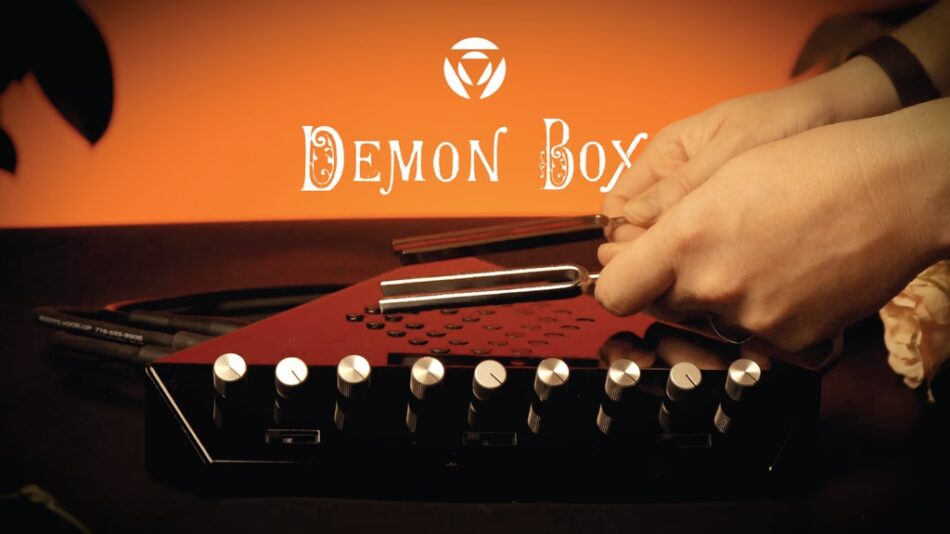Eternal Research transforms noise into new sonic possibilities with the Demon Box, an instrument that uses EMF to reveal hidden music.
Check on Kickstarter

Music is everywhere, inhabiting inanimate objects, just waiting to burst into being. Even the noisiest devices can possess a hidden elegance in the patterns of electromagnetic waves that their operation creates.
Step into a new dimension of music with the Demon Box from Eternal Research, your gateway to the unseen and unheard frequencies that surround us. By harnessing electromagnetic fields (EMF), this revolutionary analog instrument unlocks the existing music hidden in everyday things and experiences – turning anything from a hairdryer to a cell phone into music.








Does it Demon? Well, experimenting is half the fun! With the Demon Box, you can use any object emitting electromagnetic waves to create unique sounds. By isolating these waves from ambient noise, you’ll experience the subtle dynamics of magnetic waves without the distraction of background sounds. And what you thought might be one sound could sound entirely different — for instance, listen to the sound the chainsaw made in our Kickstarter video.

The Demon Box amplifies ambient electromagnetic interference, letting you explore nature’s chaos and uncover hidden musical potential. It transforms noise into the seeds of new sonic possibilities.
Here are some objects you might use to play the Demon Box:
- Mobile phones
- Wi-Fi routers
- Microwave ovens
- A tuning fork
- Electric guitars
- Computers and laptops
- Neon signs
- Old video game consoles
- Fluorescent lights
- Robotic, animatronic toys
- Radios
- Televisions
- Electric razors
- Power tools
- Speakers and audio equipment
- Anything with a small motor (like a toy train)

The Demon Box uses a proprietary configuration of 33 inductors in a triangular field that translates the electromagnetic resonances of innumerable objects and devices into three mono channels, one stereo, three CV, and midi channels that can all be used simultaneously.


The Demon Box is completely compatible with existing audio setups. It has 3 mono-audio outs, 3 CV outs, 5-pin MIDI out, as well as a USB-C port that can be used as an output or for charging. It also has a stereo mix output jack that can be used for headphones. These outputs allow the instrument to run through any mixer or directly into a computer.


The three main audio channels allow music makers to sculpt with panning, phasing and effects layering. Each of the three channels can be modified with one dedicated aux-in, and controls that allow the users to mix aux-in and inductors independently for each channel.


Eternal Research instruments are for all people trying to experience new things. At its heart, the Demon Box is a new interface to utilize EMF in expansive musical ways.
Promising to shake up the way we perceive and create with sounds, the Demon Box can immediately respond to the efforts of someone new to music making, but it is fully featured enough for professionals to engage with it to spark new creativity.
“The Demon Box is an open palette, and I didn’t want my design decisions to limit people’s view. I wanted to keep the complexity and noise in plain view, so that they can experience these phenomena and realize that the noise can be a good thing. The chaos is the music, or the seed of all new music.” – Alexandra Fierra

The original Demon Box was a 6″ x 6″ wooden prototype that housed an active bass guitar pickup with additional electronics to boost the output. However rough, this enabled us to rapidly develop the initial concept.

After many months of prototypes, the 7th iteration of the Demon Box introduced a triangular arrangement of pickups, which marked a breakthrough in our design. This led us to develop a three-channel system of mono outputs, removing left and right orientation to allow for more exploratory and innovative sound compositions. Once a prototype reached a level of perfection, Alexandra painted it to anoint it and explore its aesthetic potentials.

Here is an image of the latest iteration of the Demon Box, the thirteenth iteration over eight years. After collaborating with top industrial designers, we have perfected the 33-inductor array and the 3-channel approach. We continue to experiment with various finishes; the one below features a textured matte metal surface.

Watch a video showcasing the testing of multiple objects on the 33-inductor array, before it was placed in its final triangular housing.

A startup dedicated to new instruments, Eternal Research unlocks the existing music hidden in everyday things and experiences by harnessing electro-magnetic fields (EMF).
“The idea that new instruments have to be digital isn’t correct,” argues Alexandra Fierra, inventor and musician. “The analog world is not maxed out, even if the music is digital the experience of it, in the end, is analog. The pace of technological advance is always greater than the utilization of any one technology.”


My journey began with a deep fascination for the hidden music within the world around us. Alongside a dedicated team of musicians and engineers, I developed the Demon Box to unlock this hidden potential.
As my work evolved, I was fortunate to be joined by fellow musician and engineer Bryn Nieboer. Bryn’s extensive and varied music background, combined with a strong curiosity and self-taught approach to synths and electronics, made her the perfect collaborator. Together, we took my extremely DIY wooden box prototypes and started making our own boards and figuring out ways to make musical the noises we found.

For the software interface, I had the pleasure of collaborating with music and video artist Jordan Bortner. Together, we created an interface that enhances what the inductors can produce on their own.

We’re excited to share even more as we get closer to the big day. Thanks for reading, and I look forward to what we’ll achieve together!






